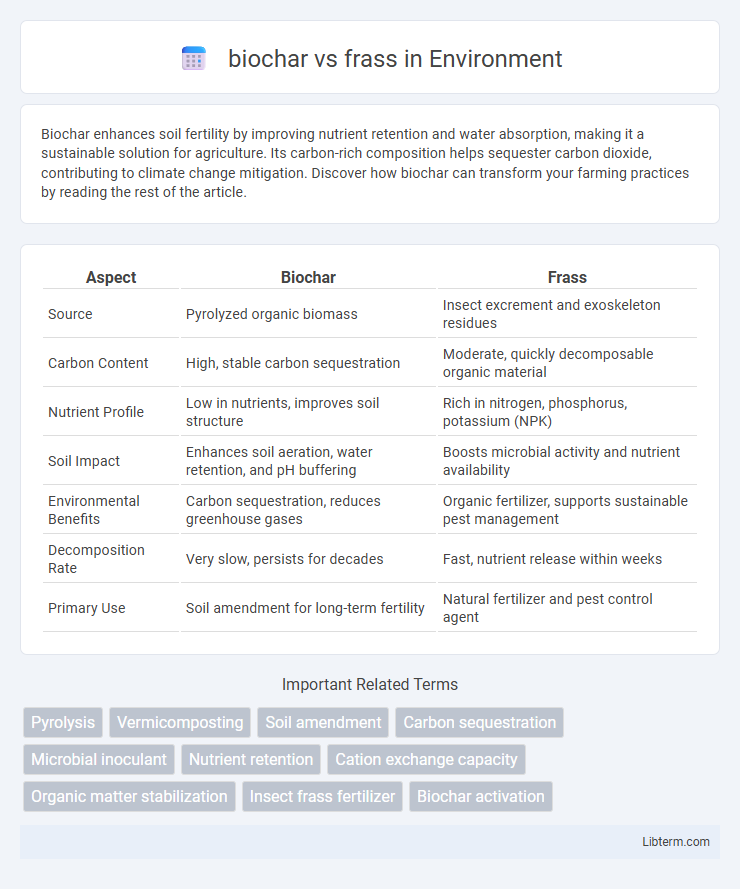Biochar enhances soil fertility by improving nutrient retention and water absorption, making it a sustainable solution for agriculture. Its carbon-rich composition helps sequester carbon dioxide, contributing to climate change mitigation. Discover how biochar can transform your farming practices by reading the rest of the article.
Table of Comparison
| Aspect | Biochar | Frass |
|---|---|---|
| Source | Pyrolyzed organic biomass | Insect excrement and exoskeleton residues |
| Carbon Content | High, stable carbon sequestration | Moderate, quickly decomposable organic material |
| Nutrient Profile | Low in nutrients, improves soil structure | Rich in nitrogen, phosphorus, potassium (NPK) |
| Soil Impact | Enhances soil aeration, water retention, and pH buffering | Boosts microbial activity and nutrient availability |
| Environmental Benefits | Carbon sequestration, reduces greenhouse gases | Organic fertilizer, supports sustainable pest management |
| Decomposition Rate | Very slow, persists for decades | Fast, nutrient release within weeks |
| Primary Use | Soil amendment for long-term fertility | Natural fertilizer and pest control agent |
Introduction to Biochar and Frass
Biochar is a carbon-rich product derived from the pyrolysis of organic biomass, used extensively to enhance soil fertility and sequester carbon. Frass, the excrement and waste produced by insects such as black soldier fly larvae, serves as a nutrient-dense organic fertilizer that promotes plant growth and microbial activity. Both biochar and frass contribute to sustainable agriculture by recycling organic waste into valuable soil amendments.
Origins and Production Processes
Biochar is produced through pyrolysis, a thermochemical process that decomposes organic biomass such as wood, crop residues, or manure in an oxygen-limited environment, resulting in a stable, carbon-rich material. Frass originates as insect excrement or processed insect biomass, primarily from larvae like black soldier flies, created through the digestion of organic waste materials under controlled conditions. The production of biochar focuses on carbon sequestration and soil amendment, while frass serves as a nutrient-rich organic fertilizer and soil conditioner derived from insect waste processing.
Chemical Composition Comparison
Biochar is primarily composed of stable carbon, including aromatic structures, with low nitrogen and high pH levels, making it effective for soil carbon sequestration and pH adjustment. Frass, derived from insect waste, contains higher nitrogen, phosphorus, potassium (NPK), and essential micronutrients such as calcium, magnesium, and trace elements, offering a nutrient-rich organic fertilizer. The chemical differences highlight biochar's role in improving soil structure and carbon content, while frass emphasizes nutrient supplementation and soil fertility enhancement.
Soil Health Benefits
Biochar enhances soil health by improving nutrient retention, increasing water-holding capacity, and promoting beneficial microbial activity, which leads to sustained soil fertility. Frass, derived from insect excrement, contributes to soil health by providing essential nutrients, stimulating microbial populations, and enhancing soil structure through organic matter enrichment. Both biochar and frass improve soil biological activity and nutrient cycling, but biochar's porous structure offers longer-term carbon sequestration benefits compared to the nutrient-dense but more rapidly decomposing frass.
Impact on Plant Growth
Biochar enhances plant growth by improving soil structure, increasing water retention, and providing a stable habitat for beneficial microbes that facilitate nutrient uptake. Frass, rich in chitin and beneficial microorganisms, promotes plant growth by stimulating root development and enhancing disease resistance through its natural bioactive compounds. Both amendments contribute to sustainable agriculture, with biochar focusing on long-term soil fertility and frass targeting immediate nutrient cycling and plant health.
Water Retention and Soil Structure
Biochar significantly enhances water retention by increasing soil porosity and moisture-holding capacity, benefiting drought-prone areas. Frass, rich in organic nutrients and chitin, improves soil structure by fostering microbial activity and promoting aggregate stability. Both amendments contribute to improved soil aeration and water infiltration but biochar excels in long-term water retention while frass boosts biological health and nutrient cycling.
Carbon Sequestration Potential
Biochar exhibits significant carbon sequestration potential due to its stable, aromatic carbon structure, which can persist in soil for hundreds to thousands of years, effectively locking away carbon. Frass, composed of insect excrement and partially digested organic material, generally decomposes faster, contributing to short-term nutrient cycling but offering limited long-term carbon stabilization. Studies indicate biochar's recalcitrant carbon content enhances soil carbon stocks more effectively compared to frass, making biochar a preferred amendment for durable carbon sequestration in agricultural soils.
Application Methods and Dosages
Biochar is typically applied to soil at rates ranging from 5 to 20 tons per hectare, mixed thoroughly into the topsoil to improve water retention and nutrient availability. Frass, an insect-produced organic fertilizer, is used at lower dosages of 0.5 to 3 tons per hectare, often applied as a top dressing or incorporated into compost to boost microbial activity and soil fertility. Both biochar and frass improve soil health but require tailored application methods for optimal crop response and environmental benefit.
Environmental Impacts
Biochar significantly enhances soil carbon sequestration, reducing greenhouse gas emissions and improving soil fertility due to its stable carbon structure. Frass, as an organic insect waste byproduct, contributes to nutrient cycling and can reduce chemical fertilizer dependency, but its carbon storage capacity is lower than biochar's. Both materials support sustainable agriculture, yet biochar offers more robust long-term environmental benefits through enhanced soil carbon stabilization.
Cost and Accessibility
Biochar production often requires specialized pyrolysis equipment, leading to higher initial costs and limited accessibility for small-scale farmers, whereas frass, a byproduct of insect farming, is generally more affordable and readily available in regions with established insect rearing industries. While biochar can improve soil carbon sequestration and fertility, frass offers immediate nutrient content and microbial benefits at a lower price point. Cost-effectiveness and local availability make frass a more accessible soil amendment option for resource-limited agricultural communities.
biochar Infographic

 libterm.com
libterm.com